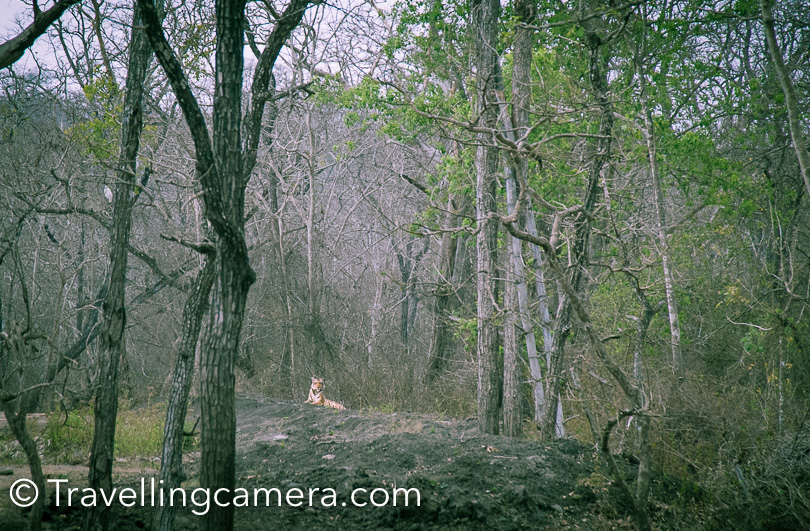It
was really thanks to Aircel that our trip to Ranthambore became so much
more than a Tiger Safari. And that says a lot really because this was
also our first successful Tiger Safari in the terms that we actually
spotted two almost full grown tigers in a single safari. No words are
enough to describe what we felt when the majestic beast was before us,
but overall there are so many beautiful memories of this trip that I am
already wondering how and why I have missed writing a Time-Turner post
about it.
We headed out to Ranthambore on 24th April 2014. This was a trip organized by Aircel and they picked us up from Gurgaon in the afternoon. We were headed to the Tiger Den resort just on the edge of the Ranthambore National Park. We were going to stay her for two nights and during this several activities were planned for us. However, since this is a Time-Turner post, I will focus on the lingering memories of this trip.
One of the most interesting memories of this trip were of our meeting with Mr. Yogesh Kumar Sahu, who was at that time the Field Officer of Ranthambore National Park. It was here that we gained new perspectives on Tiger Conservation and how important it is to have a holistic view of conserving the entire ecosystem rather than just focusing on safeguarding tiger population. How it is important to have the entire community, including the villagers who are at the most risk of man-animal conflict, root for tigers. And also how important it is to rehabilitate the local tribesmen who the poachers employ, who are usually just villagers on the lookout of a way to earn a living, and to give them an alternate way to feed their families.
We were also touched by how protective people who work for the protection of the jungle are towards the tigers, even the most ferocious of them. At that time, T-24 was still freely roaming around the jungle. And those who had seen the tiger or its photographs will probably remember that it really looked and acted like the King. By the time we visited Ranthambore, T-24, also known as Ustad, had already been charged with killing two human beings. However, when one blogger in our group asked how villagers react to a man-eater, the Field Officer was quick to point out that though the tiger had killed humans, it hadn't killed them for food, so it could not be termed man-eater.
We then visited an NGO that works towards resolving man-animal conflict situations. They have various vehicles stationed at convenient locations that are ready to head out at the slightest indication of trouble. These vehicles are equipped with all the necessary tools to remove a wild animal from the location of the conflict. With humans encroaching more and more upon the territory of animals, the conflict situations are becoming ever-more common. And such incidents only lead to the increase in ill-will towards animals. Such incidents also lead to villagers taking extreme actions such as poisoning of wild animals. So it is important to resolve the man-animal conflict in such a way so that neither human beings nor the animal involved is hurt in the process.
There was another facility, run by another NGO, that employs the villagers living on the tiger territory to create various types of handicraft, such as wooden artifacts, fabric etc. They not only provide villagers with an alternate way of earning their living, but also bring the concerns of people living in close proximity to wild animals out into the open. We also met some villagers who told us that for each of their cattle hurt by a wild animal, the government pays them for their loss. This was one of the measures that help keep the conflict in check.
In the evening, we went for our first safari in jeeps. We were lucky that we had the wildlife expert Mr Anish Andheria in our jeep. Throughout our safari we saw several spotted deer and sambhar and when we were on our way out, Mr Andheria heard the alarm call of a langoor and alerted us of the possibility of the presence of a tiger nearby. And very soon, Mr Andheria also spotted the large beast who had caused the alarm. Well, it looked like a huge tiger to us, but Mr Andheria enlightened us to the facts that these were actually almost full-grown cubs of T-17 who has been missing since 2012.
There were these and many more touching tiger tales that caught my fancy during this eventful trip to Ranthambore. I have written about these tigers elsewhere too. This trip as you can see was much more than a jungle safari. It was engaging, educational, and left me with several moments and feelings that I can never forget.
If you liked this post and found it helpful, I would request you to follow these things when traveling -
1. Manage your waste well and don’t litter Use dustbins.
2. Tell us if you went to a place and found it hard to locate a dustbin.
3. Avoid bottle waters in hills. Usually you get clean water in hills and water bottles create lot of mess in our ecosystem.
4. Say big no to plastic and avoid those unhealthy snacks packed in plastic bags. Rather buy fruits.
5. Don't play loud blaring music in forests of jungle camps. You are a guest in that ecosystem and disturbing the locals (humans and animals) is not polite











.jpg)
Comments